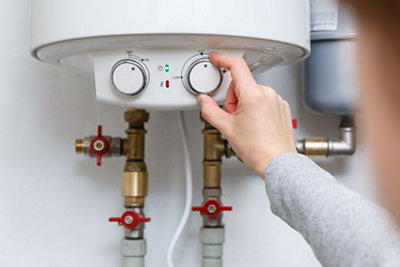How Often Should You Drain Your Water Heater Tank?
Are you ready to discover the secret to keeping your hot water flowing smoothly? Well, if you're anything like the average American, you rely on a staggering 80-120 gallons of hot water every single day. It's no wonder that hot water heaters account for a whopping 18% of a home's total energy consumption. Hot water has become an indispensable luxury that we often take for granted, but imagine how much we would miss it if it suddenly disappeared.
That's exactly why your hot water heater deserves some extra love and care. It's time to give it the attention it deserves and ensure its long-lasting performance. The key lies in regular flushing of your water heater. By flushing it out at the right intervals, you'll keep your unit in tip-top shape.
Now, let's dive into the specifics. When should you flush your water heater, and how exactly can you do it? Stay tuned as we unravel the secrets to maintaining a healthy water heater tank in your very own home.
Do You Really Need to Flush Your Water Heater Tank?
The short answer is yes. Flushing your water heater should be on your home's routine maintenance checklist.
Major manufacturers recommend this tactic, because flushing your water heater can help it stay in peak working condition. When you flush your water heater, it can also help the device to heat water with more efficiency. It can even increase your water heater's lifespan.
Why Should You Flush Your Water Heater?
Though we often think of household water as clean and sterile, the truth is that there are tiny minerals inside of it. This is true of all water, to some extent.
Throughout most of Arizona, households have "hard" water unless they've installed a water-softening system. This means that our water tends to be more mineral-rich than most. It's also particularly rich in calcium and magnesium.
If you've set up a water filtration system for your water heater, these minerals won't be a problem. However, if you don't have one, the small particles may build up inside your water heater.
If you allow this sediment to continue building, it can cause problems within the system. Enough mineral buildup can cause clogs and inefficiency. It can even cause your water heater to fail.
This is where our local hard water becomes more of a problem. Many minerals and other types of sediment, especially calcium and deposits known as limescale, can harden if they're left in place for long enough. This can make the deposits difficult or even impossible to remove.
If enough sediment has hardened in your system, your water heater may struggle to heat itself evenly. In gas water heaters, this can result in gas leaks over time, and in electric water heaters, it can cause an electrical burnout. In addition, the sediment may clog your heater's valve, making it impossible to use.
Even worse, the sediment buildup can act as an insulator. This means your tank could begin getting much too hot, which can stress the system.
In other words, failing to flush your water heater can result in expensive fixes. If you're unlucky, you may even have to replace your unit if your old one is too damaged for repair.
How Often Should You Drain Your Water Heater?
The answer to this question can vary.
For homeowners who live in an area with soft water, draining a water heater tank once a year is a great rule of thumb.
However, we recommend draining your tank twice a year in Arizona. Because our water is so hard in this region, it's crucial to remove mineral build-ups more often.
There's also no harm in even more frequent maintenance. Routine cleaning can help you improve your home's water quality if you've noticed strange odors or rusty water.
In addition, flushing your water tank can help you troubleshoot odd noises from your water heater. If hardened sediment bangs against the side of your tank as new water flows into it, a flush can get rid of the buildup and the noise. Last, if you ever think your hot water heater may be the culprit behind higher utility bills, flushing the system can sometimes help.
What's the Difference Between Draining and Flushing?
Before we move on, it's important to understand that "draining" and "flushing" are not interchangeable words in this context.
When you drain your water heater, you're removing the water from within it. This can help get rid of any built-up sediment at the bottom of the tank. During this process, the water supply to the system is off.
When you flush the tank, on the other hand, the process is more thorough. You'll leave the system's water supply on, replacing the water in the tank with a constant flow of running water. This flowing water can wash away the mineral buildup on the bottom of your tank.
How Do You Flush Your Hot Water Heater?
This task is a relatively quick one. The process will take around 10-30 minutes, depending on the system and its size, though the unit will take a few hours to drain.
Preparing to Flush Your System
You don't need special tools or plumbing experience for this type of water heater maintenance. You may, however, want to grab a pair of gloves and some old clothes. In addition, don't forget that your hot water system shouldn't be in use while you're performing this maintenance.
If you don't want to deal with hot water, you can turn your water heater off a few hours before you plan to perform the flush. Alternatively, you can make sure to use up your hot water before flushing your tank by running laundry on hot, taking a hot shower, etc.
Steps to Flush Your System
Start by turning off your water heater's gas or electrical power. You'll also need to shut off the cold water supply to the unit via the cold water inlet valve. This may look different from brand to brand, but you can check your owner's manual for details.
Next, turn off or turn down the water heater's temperature. For modern heaters, this is easiest to do with "vacation" mode. Lowering or shutting off the heat settings keeps the device from trying to heat water when there's nothing in the tank.
Attach a garden hose to the drain valve, which you'll find at the bottom of your water heater. Bring the other end of the hose to a drainage area, such as a large container, the backyard away from your house, or a storm drain.
Turn on one or more hot water faucets somewhere in the house as the water flows. This can help with drainage.
At this point, you can open your water heater's drain valve. To flush the tank, keep the valve open until the water coming from the garden hose begins to run clear.
Once you're ready, turn the cold water supply back on. As stated above, this helps to flush any remaining sediment or mineral content out of the bottom of your tank. Opening and closing the cold water supply a few times may help ensure a stronger flush.
Gauge how long to flush the tank by checking to see if clear water is running from the hose. When the water runs clear and not tinted, close the drain valve and remove the garden hose.
Now you can start to refill the water heater by turning the cold water supply back on. Check your open hot water faucets: the water flowing from them might look cloudy at first, but it should clear after a minute.
Last, it's time to restart the system. Reopen the gas supply or turn on the power and let your tank begin heating water as usual.
Do You Still Need Professional Maintenance?
Though flushing your water heater is a great way to help maintain the unit, it's not the end of the story.
A professional water heater inspection by a licensed plumber can help ensure the safe and efficient running of your system. You'll want to reach out for an inspection at least once every year. However, it's a good idea to check in more often if you've noticed rising bills, lower heater efficiency, odd noises, or corrosion.
In addition, a plumber should help with your water heater flush in certain situations. For example, if you open the drain valve during a flush and no water comes out, a professional can help you decide what to do about any sediment that may have clogged the valve. If it's been a while since you last flushed and drained your water heater, or if you just bought a house with an aging system, a professional is your best bet for reducing the chances of a catastrophic leak.
If you run into problems during any part of a water heater flush, a professional can help you decide whether you should repair or replace the system.
Keep Your Water Heater in Shape
Now that you've stopped wondering, "How often should you drain your water heater?" It's time to get your system in shape! Clearing mineral content from the bottom of the tank is a great way to maintain your unit's efficiency and lifespan.
Whether you need help flushing your water heater or you'd like to repair or replace a unit, Parker & Sons is here to help. Schedule a visit with us today, or contact us with questions.
Related Reading
Subscribe to our e-Newsletter
Stay up-to-date on current news, promotions, and industry tips.

